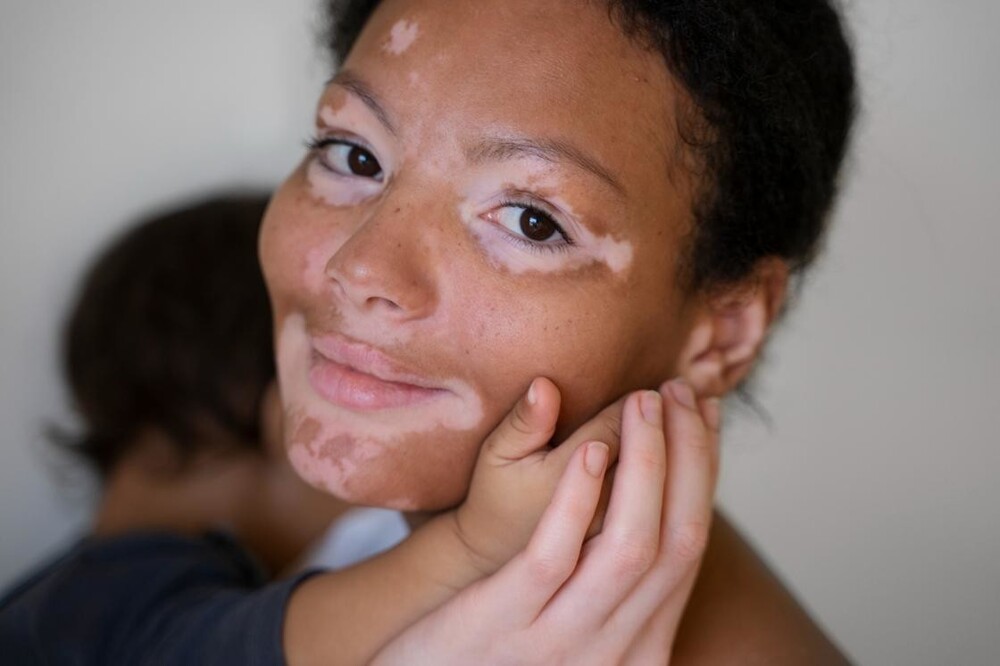Blank spot in medicine: the history of vitiligo (8 photos)
What problems do people with this disease face, is it contagious and how many prejudices are there in the world associated with it. 
What is vitiligo? These are individual areas of the skin that have lost their natural pigment. They can be discolored to a milky tint, and if the disease is ignored, the pigment spots will certainly grow.
The lesion can appear on any part of the body, most often the knees, elbows and hands. With a localized form, there can be a maximum of two spots in one place, and with a generalized form - throughout the body and up to 80% of the whole body can be affected. It can even touch the scalp and palate. 
The danger is that discolored areas of skin are completely defenseless under the sun's rays and the patient can become severely burned in a few minutes. Sunburn, in turn, can lead to accelerated growth of white spots on the body. 
You cannot become infected with vitiligo. Only one percent of the world's population has the disease (some estimates say 2%), but the incidence varies by continent, region and ethnic group.
Vitiligo can occur in anyone and at any age. In half of the patients, the manifestation is observed before the age of 20.
Unfortunately, in third world countries, people with vitiligo still face social stigma. Many people still try to avoid sick people, having no idea about the nature of the disease. That is why June 25 is declared Vitiligo Day, so that as many people as possible learn about the disease and its origin. 
Today, not much is known about vitiligo. There are theories why it occurs at all:
the body reacts to stress in this way;
genetics. But this is a rather controversial theory; studies have shown that degrees of relationship can be identified only in 5-6% of cases;
immune disorders, that is, loss of pigment occurs as a result of autoimmune processes;
oxidative stress: cells are rapidly destroyed by oxidation. By the way, this same process is partially responsible for the aging of the entire organism. 
Model with vitiligo
Research into vitiligo is still ongoing, but the exact cause has not yet been identified. None of the above reasons excludes the others.
Medicine is practically unable to help a sick person. The disease can either go away on its own or remain with the patient forever. Usually the patient is prescribed gels with corticosteroids, and for those who suffer from the generalized form - tablets.
Discussions are ongoing, but no truly effective therapy has yet been invented. Stains are often simply hidden with foundation. 
OK then. Stains and stains. Fortunately, today the world is already coming to the point that people with various diseases that affect their appearance no longer have to sit at home and “keep a low profile.” But social ostracism still prevails; even adults can point the finger at the sick, let alone children. A person with vitiligo can become so self-conscious that it results in severe depression. And they already need help not only from dermatologists and trichologists, but also from psychotherapists and psychiatrists. 
Atlas 1905
How long has humanity known about vitiligo?
A long time ago, even before our era. But since the word “Vitilīgō” (Latin) was used to describe almost every skin disease, it is difficult to establish whether it was vitiligo, or lichen or leprosy.
The Ebers Papyrus (circa 1500 BC) contains a very similar description of vitiligo. In the works of Hippocrates, in the Indian Athaorva Veda (circa 1400 BC) and in the works of Aulus Cornelius Celsus (circa 50 BC), one can also see a description of a disease very similar to vitiligo.
Doctors in those days considered any skin disease to be leprosy, so a “spotted” person was most likely simply sent to a leper colony - a hospital for lepers. 
It took many years to understand that this disease is not contagious. Vitil for the first timeyoke was developed as a separate disease in 1842. The Englishman D. Danielson wrote a scientific work in which he proved that such a peculiar pigmentation is absolutely not similar to leprosy.






















